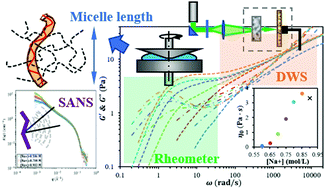From well-entangled to partially-entangled wormlike micelles†
Abstract
We combine mechanical rheometry, diffusing wave spectroscopy (DWS), and small angle neutron scattering (SANS) with a simulation model, the “pointer algorithm”, to obtain characteristic lengths and time constants for wormlike micelle (WLM) solutions over a range of salt concentrations encompassing the transition from unentangled to entangled solutions. The solutions contain sodium lauryl ethylene glycol sulfate (SLE1S), cocamidopropyl betaine (CAPB), and NaCl. The pointer algorithm is extended to include relaxation of unentangled micelles, allowing micelle parameters to be extracted from the rheology of partially entangled solutions. DWS provides the data at high frequency needed to determine micelle persistence length accurately. From pointer algorithm fits to rheology, we observe a salt-induced rapid change in micellar length as the solution enters the well-entangled regime and a weaker growth with surfactant concentration consistent with mean-field theory. At a lower surfactant concentration, micelle length and persistence length from SANS are roughly consistent with values from rheology once the lower surfactant concentration used in SANS is accounted for. This is, to our knowledge, the first time that quantitative comparisons of structural features including micelle length are made between rheology and SANS. Finally, scaling laws for micelle diffusion and recombination times indicate that micelle kinetics are reaction controlled leading to mean-field recombination with surrounding micelles over the entire range of concentration of interest except at very low and very high surfactant concentrations where either short micelles or branched micelle clusters are dominant.



 Please wait while we load your content...
Please wait while we load your content...